Last updated on December 12th, 2024 at 04:22 pm
Want to learn how to make macarons? We’ve all heard how finicky and stressful they are, so here are the best macaron tips for making perfect macarons at home.
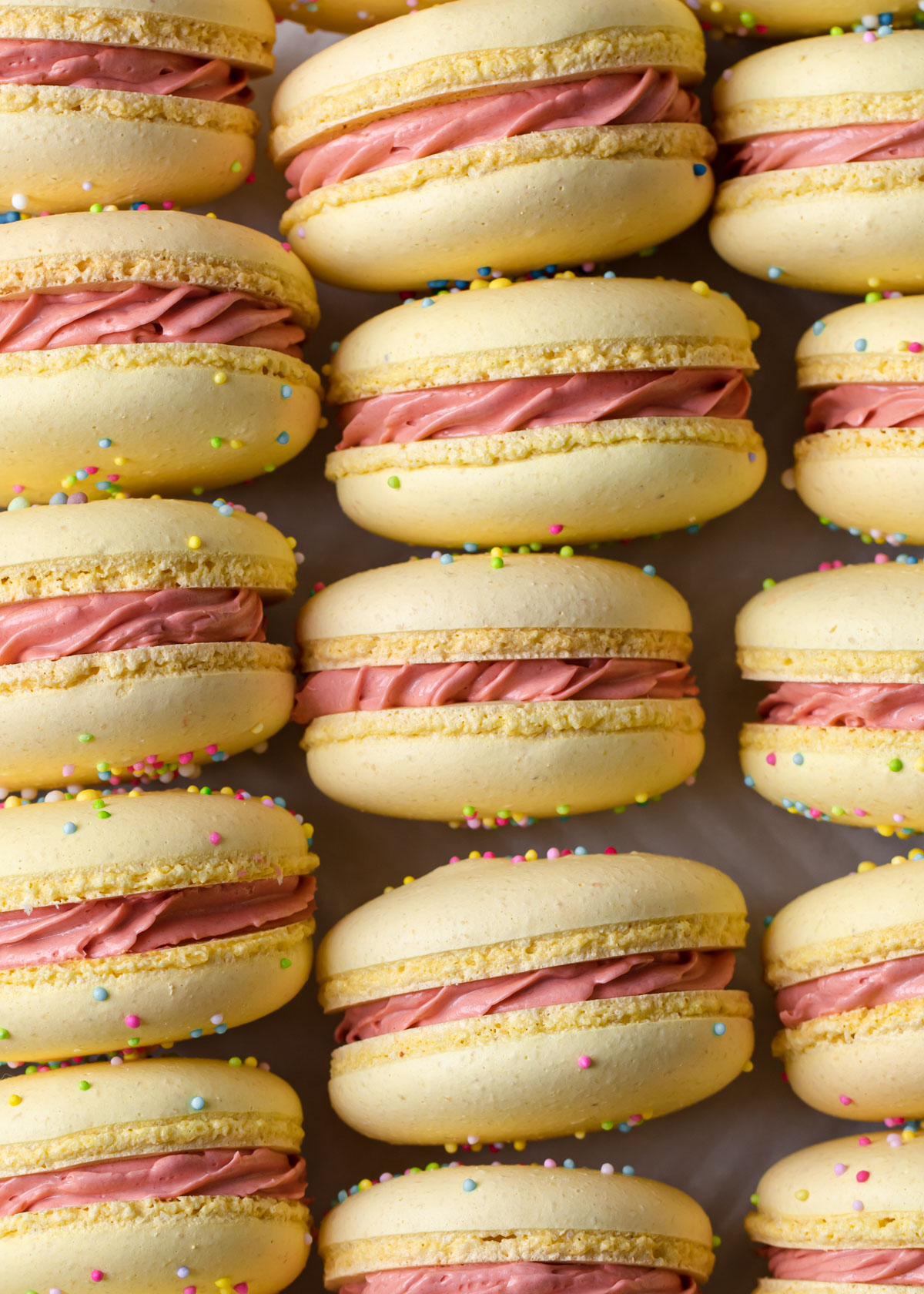
Characteristics of French Macarons
French macarons are so cute and dainty. With their little “feet” around the edges, colourful shells, and an assortment of fillings, they are easy to fall in love with. But what makes a macaron great?
A French macaron is composed of two parts: the shell and the filling. A well executed shell will be crisp on the outside and chewy in the middle. It is free from cracks and has developed feet.
They are round and uniform in shape, smooth on top, and won’t be hollow inside. I know it’s a lot to ask of such little cookies, but I promise you can get there with these macaron tips!
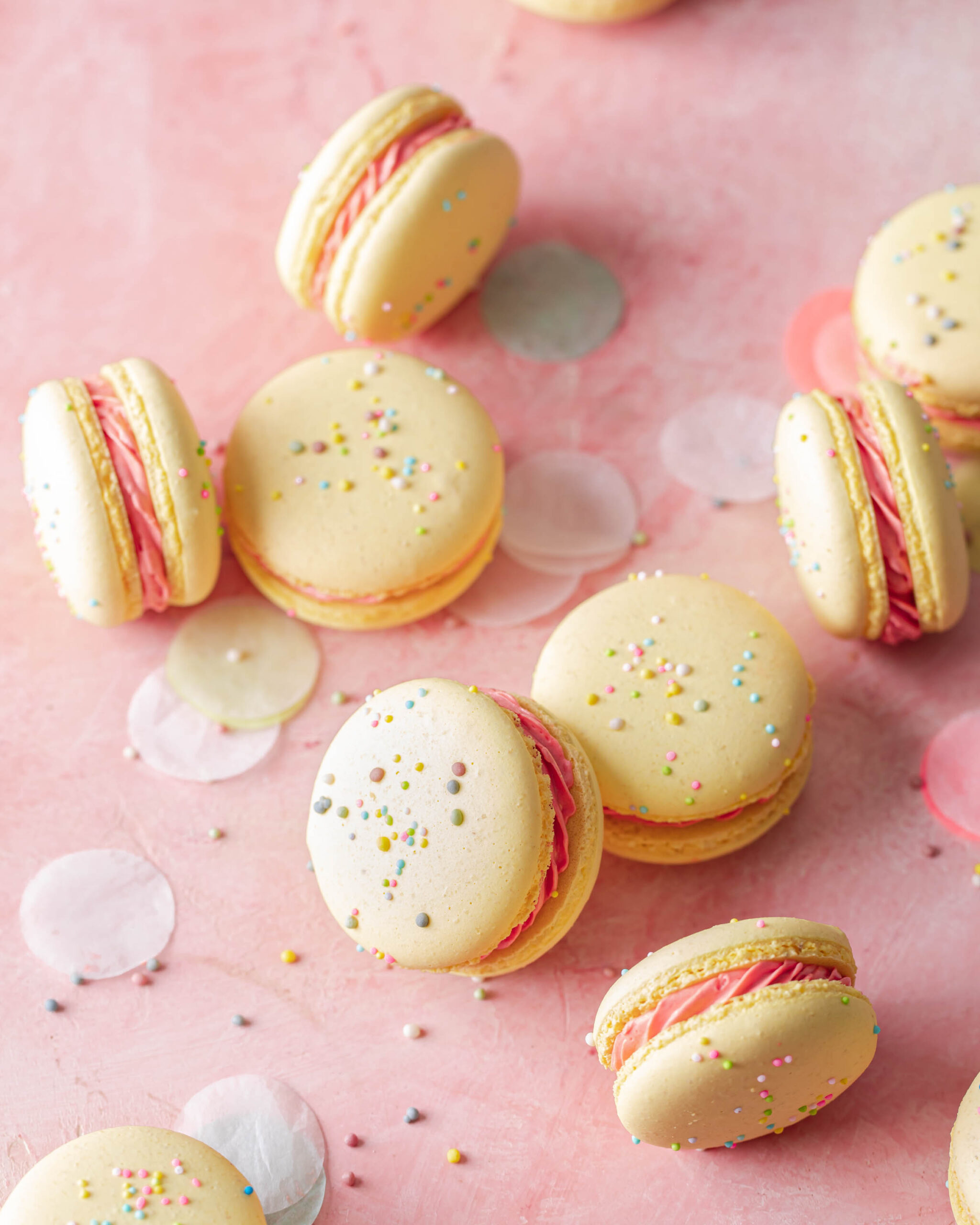
What to Fill French Macarons
The filling is much more forgiving. Most any buttercream or frosting will do. If you’d like, pipe a ring of buttercream around the edges, then fill the centers with fruit jam, citrus curd, or chocolate ganache!
Pink Peppercorn Ganache Macarons
French Macaron FAQS
Use egg whites from fresh eggs. Unless you have a reliable brand of carton egg whites that you trust for making meringue, then make sure to use egg whites from whole eggs. Save the yolks for another recipe.
The oven was too hot or they were not mixed properly.
There was no rest period. It is important for a skin to develop on top of the shells before baking. This way, the shells rise and the heat escapes out the bottom and creates “feet” instead of bursting through the tops.
The egg whites were likely over-beaten or the meringue mixture was mixed too long. This could also be a result of the shells resting too long before baking.
The Best Macaron Tips to Master
Macaron shells are made up of almond flour and meringue (whipped egg whites and granulated sugar). No matter which type of meringue you prefer to use, make sure you have a good grasp on how to make a great meringue.
The stronger your meringue, the easier it will be to fold the ingredients together and for the macarons to keep their shape when baked.
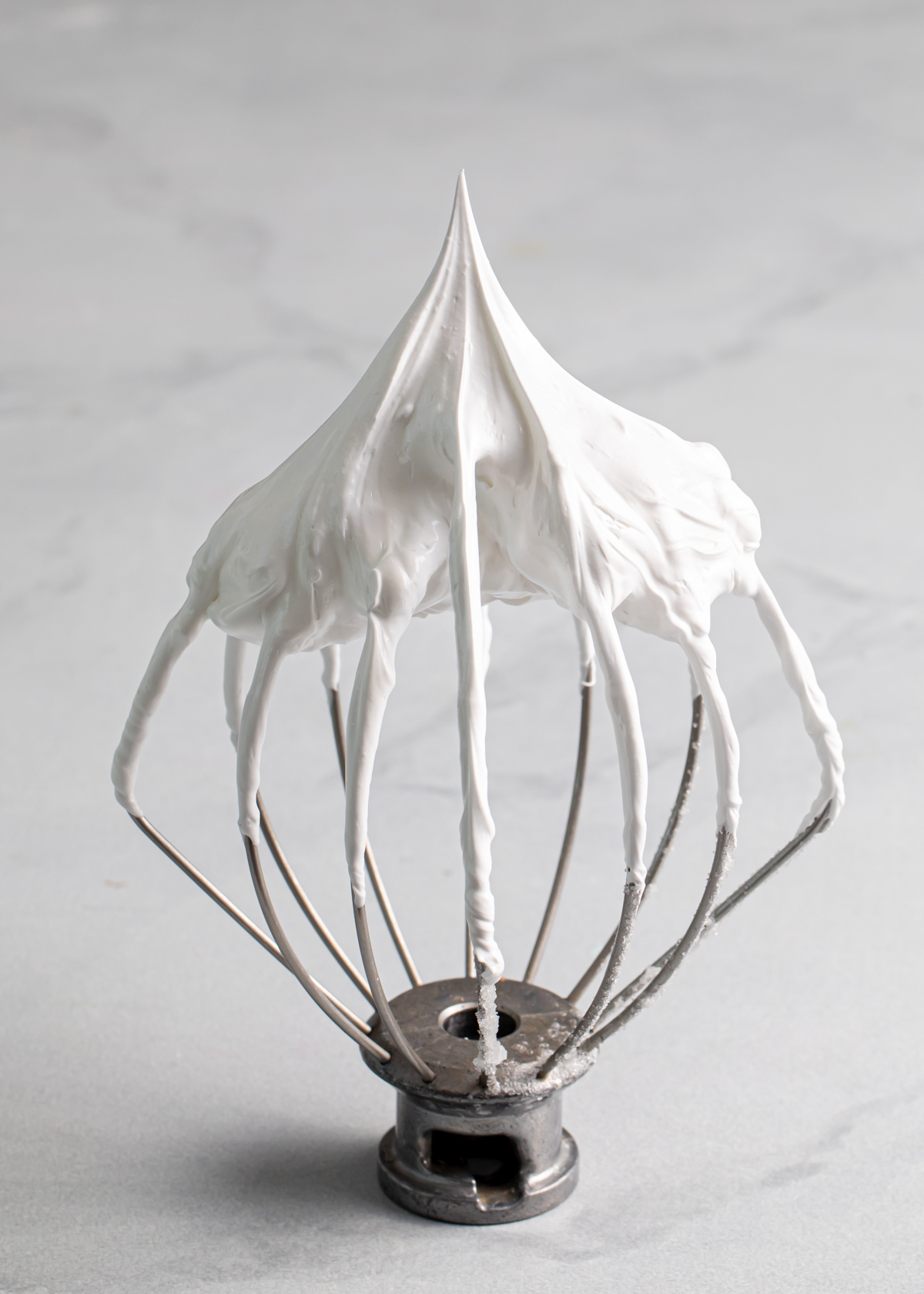
Perfecting Meringue
To make a great meringue, make sure your egg whites and all of your equipment are free from fat (egg yolks) and grease. Whip the whites until they are shiny and hold stiff peaks. For more tips on meringue, read here about Angel Food Cupcakes.
Italian meringue takes longer and requires your to boil water and sugar together first, but it is much more forgiving and stable than French meringue.
Weigh your macaron ingredients
We all know that weighing ingredients is far more accurate than using measuring cups. Confession: I don’t always weigh my ingredients. But, when it comes to making macarons, I always use my kitchen scale.
Especially when working with things like eggs/egg whites where one might be large/smaller than the other, it is important to weigh ingredients. Trust me, if you are going to be putting in all the work to make a perfect macaron, you don’t want to skip this simple step.
Mix with care and purpose - aka Macaronage
Slow and steady wins the race. Instead of short, quick strokes, go for big, intentional folds when combing the whipped meringue and almond flour mixture. This process is called macaronage.
One of the biggest mistakes you can make is over-mixing the batter. People tend to over-mix the batter due to inefficient macaronage. The goal is to use the least amount of folds to get the job done, so make sure each one counts! Faster is not better.
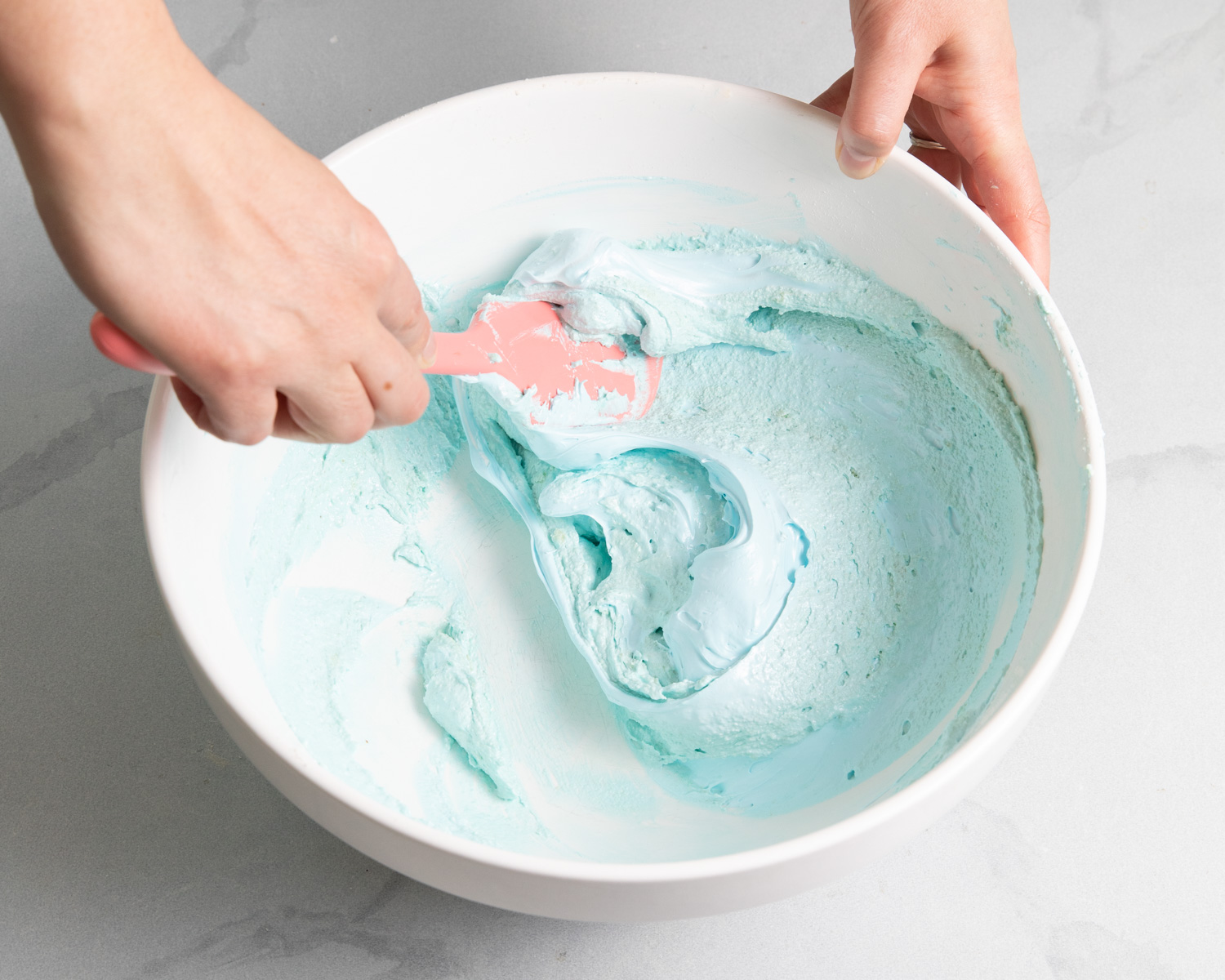
When to stop mixing macarons
Piggy-backing on the last tip, it is important to know when to stop mixing. Since we are going slow and steady (see above), take care to evaluate the batter as it comes together.
When properly mixed, the batter should flow like lava - smooth and slow. If you pull you spatula through the center of the bowl, the batter should spilt then slowly come back to the center.
If it floods back in immediately, then batter is over-mixed. It’s better to have a few remaining lumps in the batter than over-mixing the whole batch.
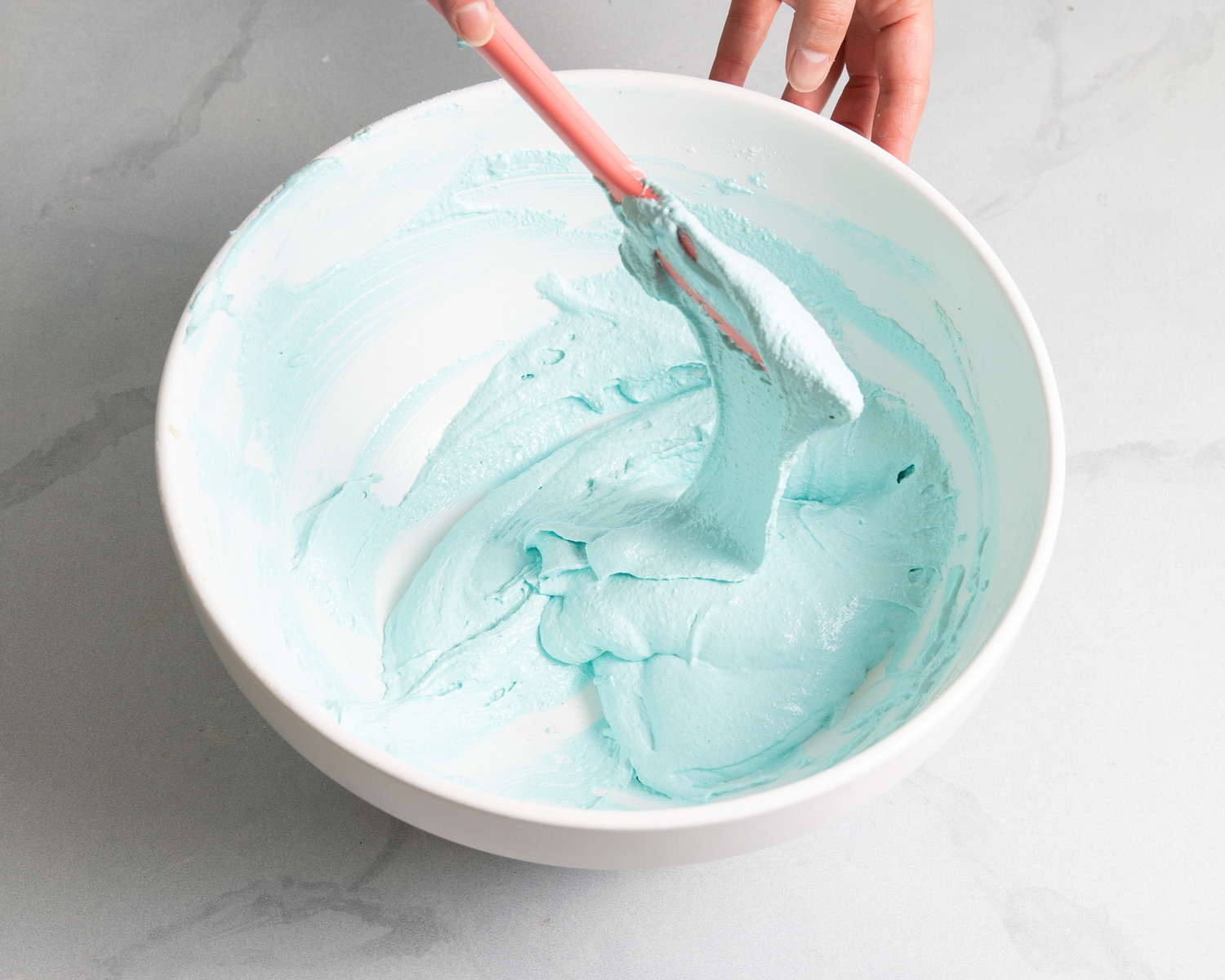
Another way to test the batter is to scoop some up with the spatula, then wave it back and forth into the bowl. The batter should fold over on itself like ribbon and not break.
Adding color to macaron batter
Use gel food coloring. This means we are not adding liquid to our batter and disrupting the ratios of ingredients. Alternatively, try powdered food coloring.
When possible, add the gel food coloring during the final minute of the whipped meringue. Adding it then helps keep from over-mixing it into the batter. Remember that you can always add more coloring when you are folding later on.
Keep in mind that the color of the tinted meringue will lighten up and take on a slightly yellow hue once combined with the almond flour mixture.
Use a template for piping macarons
In order to create round macarons that are uniform in size, try using a template. Especially if you are newer to piping, a template will help guide you.
Trace circle on a piece of parchment paper. The circles should be about 1.5 inches in diameter. The bottom of a large piping tip is usually a great size.
When piping, flip the parchment paper upside down. Use a pen/pencil that is dark enough to see through the other side. Alternatively, slip the parchment template under a silicone baking mat as you pipe, then remove it before baking. The macarons will likely increase slightly as they bake, so pipe the batter a little smaller than the size that you want your final shells to be.
My French Macaron Recipe
Let them rest
After you’ve used all of your macaron batter and they are all piped and ready to go, allow the shells to rest. This rest period is important for creating smooth shells and forming feet on the bottom.
As the batter rests, a slightly skin will form on top of the shells. When they bake, the shells will rise straight up and feet will produce around the edges rather than the hot air bursting through the tops of the shells.
Rest time may very in different temperatures and level of humidity. Plan for a rest of about 30 to 45 minutes. To test, gently touch the top of a shell. When ready to bake, it will no longer be sticky.
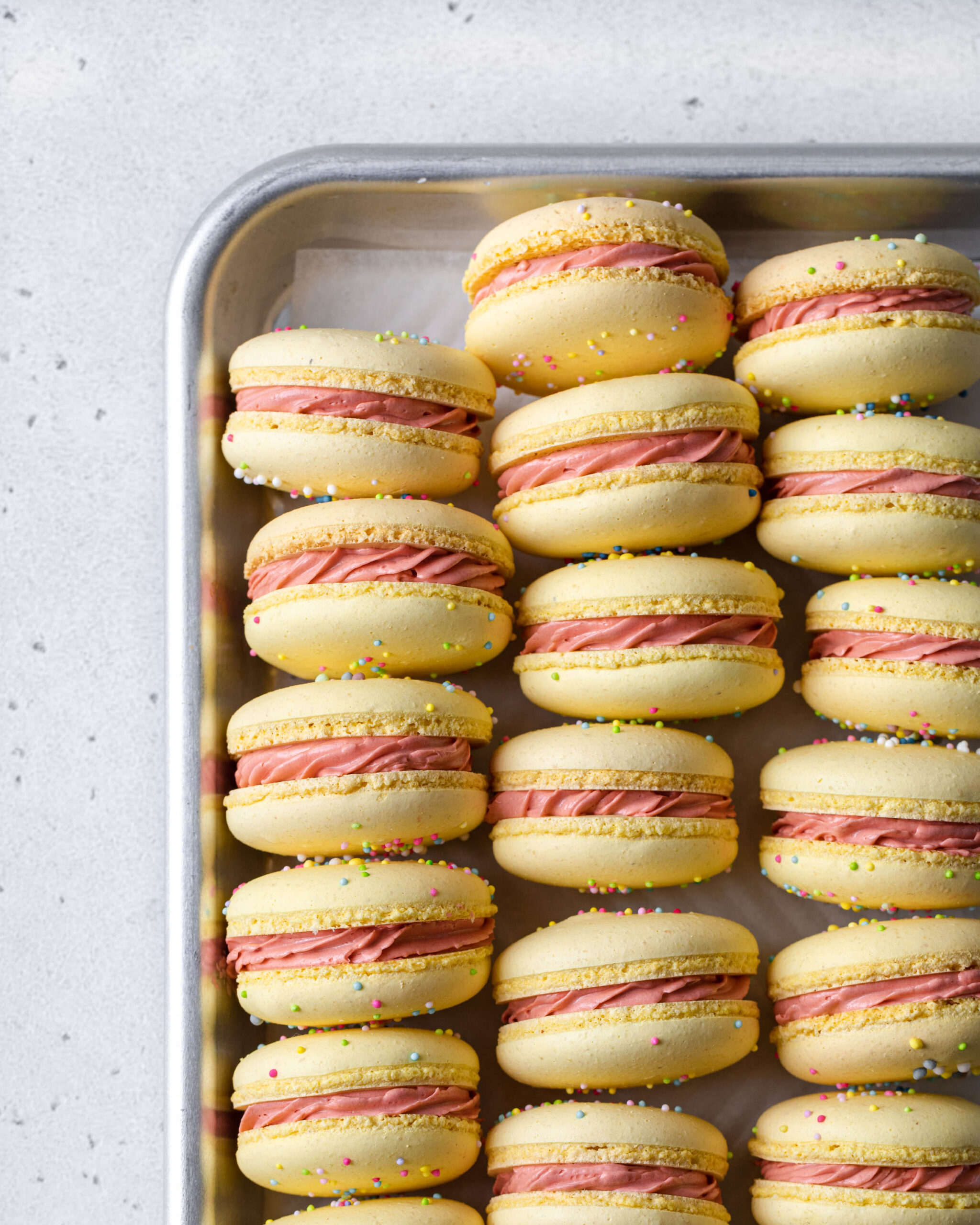
Be prepared
Making perfect macarons is all about precision and timing. Many of the steps move along rather quickly. Having all of your ingredients weighed out ahead of time and your equipment out and ready to go will certainly help.
My two final tips are to read the recipe all the way through before getting started (maybe even twice, if the recipe is new you), and try to have a little fun. Unless they are burnt to a crisp, they will likely still taste good even if they aren’t as perfect as those found at a Parisian bakery.
Recipe
Vanilla French Macarons
Ingredients
For the French Macarons
- 1 ¼ cup (145g) almond flour
- 1 cup + 3 tablespoons (145g) confectioners' sugar
- 105 grams egg whites
- ⅔ cup + 1 tablespoon granulated sugar
- ¼ cup water
For the Vanilla Buttercream
- ½ cup (113g) unsalted butter softened
- 1 ½ to 2 cups (188 to 210g) confectioners' sugar
- 2 teas pure vanilla extract
- 1 to 2 tablespoon milk as needed
Instructions
To Make the French Macarons
- Line two to three baking sheets with non-stick silicone baking mats or parchment paper and set aside. Fit a large piping bag with a round tip, ¼ to ½-inch wide in diameter, and set aside.
- Place the almond flour and confectioners’ sugar in a food processor. Grind until fine, 30 to 60 seconds. Using a fine mesh sieve, sift the almond flour mixture into a large mixing bowl. Press any clumps through the sieve with a rubber spatula.
- Place the granulated sugar and water in a saucepan and gently swirl together. Heat the sugar mixture on the stove over high heat. Without stirring, bring the sugar mixture to a boil. Keep boiling until the sugar syrup reaches 238°F on a candy thermometer, or soft ball stage.
- Meanwhile, place half of the egg whites (about 52-53 grams) in the bowl of a stand mixer fitted with a whisk attachment. Once the sugar syrup reaches 230°F, begin whipping the egg whites on medium-high speed until they turn white and hold soft peaks - like wispy clouds.
- Once the sugar syrup reaches 238°F and the egg whites are whipped to soft peaks, very carefully pour the sugar syrup into the egg whites with the mixer running on high speed. Pour the hot syrup in a steady stream - not too slow that it dribbles and spills, and not too quickly that you lose control or shock the delicate egg whites.
- After the sugar syrup has been added to the egg whites, continue to whisk on high speed until stiff peaks form and the meringue returns back to room temperature, 6 to 8 minutes. Add gel food coloring to the meringue during the last minute of mixing.
- Meanwhile, add the remaining egg whites (about 52-53 grams) to the sifted almond flour mixture. Stir the ingredients together with a rubber spatula until the mixture turns into a paste. Press and smear the paste against the side of the bowl to remove lumps.
- Add about ⅓ of the meringue to the almond mixture and mix until they just start to combine. You don’t need to be as delicate here. Stop before the two mixtures are fully combined.
- Continue to fold all of the meringue into the batter (see Macranoge for more info). Do not over-mix. The batter is done mixing when you can lift up a small portion with the spatula and slowly wave it back and forth, like a ribbon, without it breaking. The “ribbon” should melt back into the batter in about 30 seconds.
- Fill the prepared piping bag with the macaron batter. Holding the bag straight down, pipe small, uniform mounds on the lined baking sheets. The macarons should be 1 to 1 ½-inches in diameter, piped about an inch apart. Sprinkle with rainbow sprinkles, if desired.
- After one full baking sheet is piped, it is time to tap the bottom of the pan. This releases any trapped air bubbles and helps any peaks left from piping settle flat. (See Pipe and Tap).
- Preheat the oven to 325°F and set the piped macarons aside to rest. Rest the macarons until a skin forms on their tops, 20 to 45 minutes. They are ready to bake once the oven is preheated and the tops are dry and not sticky when gently touched with a finger.
- Bake one baking sheet at a time (or two small sheets, if they fit on the same rack) for 12 to 14 minutes. Cool macarons completely on their baking sheets set over a wire cooling rack.
To Make the Vanilla Buttercream
- Place the softened butter in a stand mixer fitted with a paddle attachment, or in bowl with a hand mixer, and mix on medium-low until creamy. Stop the mixer and add about half of the sugar. Mix on low speed until combined.
- Gradually add in the remaining ingredients until incorporated, then turn the mixer up to medium-high speed. Mix on medium-high speed until light and fluffy, 2 to 4 minutes.
- To assemble, find similarly sized shells and set them down in pairs on a clean baking sheet, one shell facing up and the other facing down. Pipe the vanilla buttercream on the bottom shells, leaving a very small border around the edge. Place the matching shells on top of the filling and gently sandwich together until the buttercream presses out to the edges of the feet.

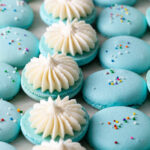
Leave a Reply